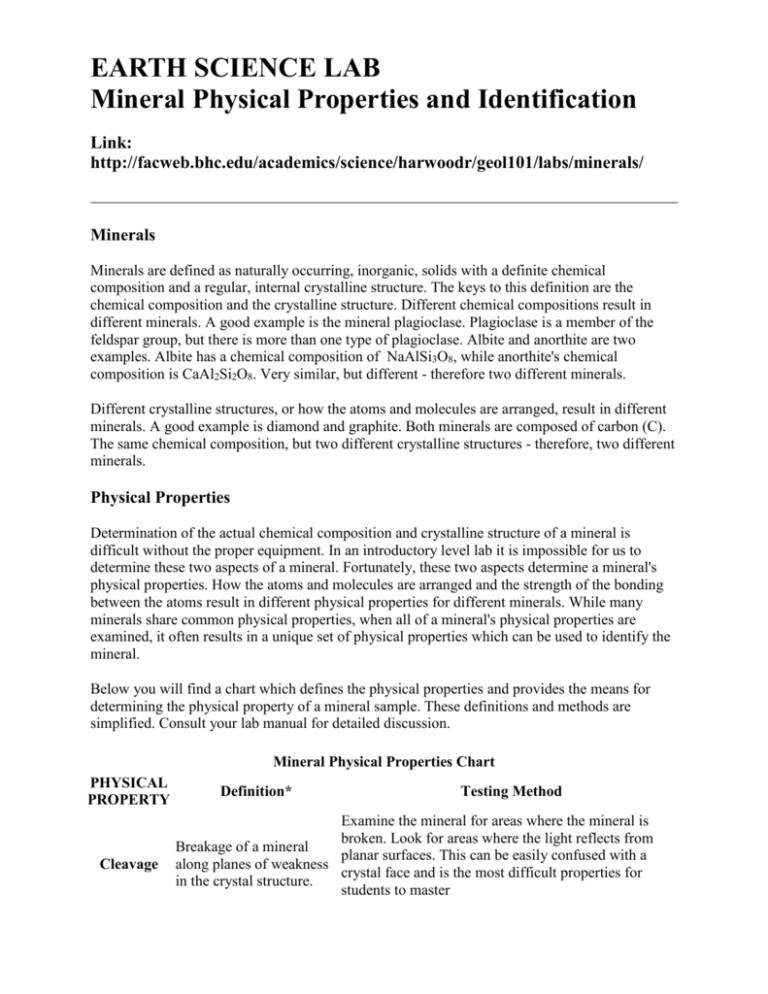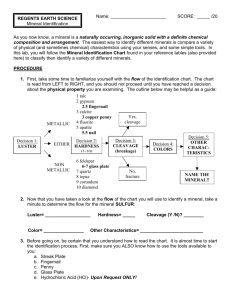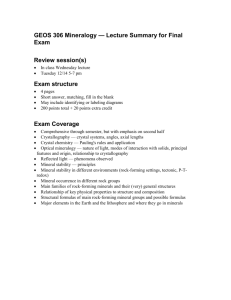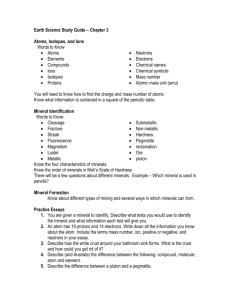Mineral Identification Lab: Physical Properties & Tests
advertisement

EARTH SCIENCE LAB Mineral Physical Properties and Identification Link: http://facweb.bhc.edu/academics/science/harwoodr/geol101/labs/minerals/ Minerals Minerals are defined as naturally occurring, inorganic, solids with a definite chemical composition and a regular, internal crystalline structure. The keys to this definition are the chemical composition and the crystalline structure. Different chemical compositions result in different minerals. A good example is the mineral plagioclase. Plagioclase is a member of the feldspar group, but there is more than one type of plagioclase. Albite and anorthite are two examples. Albite has a chemical composition of NaAlSi3O8, while anorthite's chemical composition is CaAl2Si2O8. Very similar, but different - therefore two different minerals. Different crystalline structures, or how the atoms and molecules are arranged, result in different minerals. A good example is diamond and graphite. Both minerals are composed of carbon (C). The same chemical composition, but two different crystalline structures - therefore, two different minerals. Physical Properties Determination of the actual chemical composition and crystalline structure of a mineral is difficult without the proper equipment. In an introductory level lab it is impossible for us to determine these two aspects of a mineral. Fortunately, these two aspects determine a mineral's physical properties. How the atoms and molecules are arranged and the strength of the bonding between the atoms result in different physical properties for different minerals. While many minerals share common physical properties, when all of a mineral's physical properties are examined, it often results in a unique set of physical properties which can be used to identify the mineral. Below you will find a chart which defines the physical properties and provides the means for determining the physical property of a mineral sample. These definitions and methods are simplified. Consult your lab manual for detailed discussion. Mineral Physical Properties Chart PHYSICAL PROPERTY Cleavage Definition* Testing Method Examine the mineral for areas where the mineral is broken. Look for areas where the light reflects from Breakage of a mineral planar surfaces. This can be easily confused with a along planes of weakness crystal face and is the most difficult properties for in the crystal structure. students to master Visible light spectrum Look at the sample and determine its color - white, radiation reflected from a black, green, clear, etc. mineral. Examine and describe the geometric shape of the Geometric shape of a Crystal Form mineral - cubic, hexagonal, etc. Not commonly seen in crystal or mineral. most introductory lab samples. Breakage of a mineral, not Examine the mineral for areas where the mineral is Fracture along planes of weakness broken. Describe the breakage as either irregular or in the crystral structure. conchoidal (has the appearance of broken glass) Use minerals of known hardness from the Mohs Hardness Kits. Scratch the unknown mineral with a Resistance to scratching or Hardness known hardness to determine which mineral is harder. abrasion. Continue doing this with harder or softer minerals from the kit until the hardness is determined. Look at the sample to determine if the mineral is Character of the light Luster metallic in appearance (looks like a chunk of metal) or reflected by a mineral. non-metallic (doesn't look like a chunk of metal). Electromagnetic force Use a magnet to determine if the magnet is attracted to Magnetism generated by an object or the sample. electrical field. Chemical interaction of Place one small drop of HCl on a sample a watch for a Reaction to hydrochloric acid and reaction - effervesces (bubbles). HCl calcium carbonate (CaCO3). Ratio of the mass of a Generally not determined in an introductory lab. Look Specific mineral to the mass of an this information up in your lab manual once the mineral Gravity equal volume of water. has been identified. Grind a small amount of a mineral into a powder on a Color of the mineral when Streak porcelain streak plate and determine the color of the it is powdered. powder. Nerve ending reaction in Lick the mineral. (not recommended in an introductory Taste the tongue to different lab - you don't know who has handled or licked the chemicals. sample before you). Requires special equipment such as a UV lamp and Other Fluorescence, geiger counter. These are not commonly tested for in an Properties Radioactivity introductory lab. * Definitions simplified or modified from Bates, R.L. and J.A. Jackson (eds.), 1987, Glossary of Geology. American Geological Institute, Alexandria, VA, 788 p. Color Below is a table listing some of the aspects of the common lab minerals. This table is not a complete listing of all of the physical properties for each mineral. It is designed to highlight those physical properties that are unique to that mineral or assist in identification of that mineral. Be aware that not all mineral samples will necessarily show these physical properties. For example, all plagioclase has cleavage. The sample you examine may or may not show that cleavage. All minerals have a crystal form. However, rarely do introductory mineral samples show a good crystal form. Some types of minerals rarely show a crystal form and even museum collections may not contain good examples of a mineral's crystal form. Mineral Identification - Diagnostic Physical Properties Apatite Green color, H=5, may show hexagonal crystal form Dark or dull green color, 2 cleavages at ~90 degrees, similar properties to Augite Hornblende Black color, one perfect direction of cleavage resulting in the mineral pealing into Biotite thin, flexible sheets, similar properties to Muscovite Calcite H=3, reacts with HCl, 3 directions of cleavage (rhombic cleavage) Corundum H=9, often shows hexagonal crystal form Dolomite Reacts to HCL in its powdered form, similar properties to calcite H=4, 4 directions of cleavage, often purple in color (can be white, clear, yellow, Fluorite green) Galena Gray, metallic mineral, 3 directions of cleavage (cubic) Typically reddish brown color, no cleavage, commonly found in twelve-sided Garnet crystals (dodecahedrons) Graphite "Pencil lead", soft metallic mineral, gray streak Gypsum H=2, can be scratched with a fingernail "Salt", H=2.5, cannot be scratched with a fingernail, 3 directions of cleavage (cubic), Halite salty taste Hematite Reddish brown streak, "rust" Black to dk. green color, 2 directions of cleavage at 120 or 60 degrees, similar Hornblende properties to Augite Magnetite Magnetic, metallic mineral Clear or translucent color, one perfect direction of cleavage resulting in the mineral Muscovite pealing into thin, flexible sheets, similar properties to Biotite Apple green or yellowish green color, H=7 (often difficult to determine), conchoidal Olivine fracture, no cleavage H=6, salmon pink color is typical, perthitic intergrowths are common, 2 directions of Orthoclase cleavage at 90 degrees, similar properties to plagioclase H=6, white or gray color, striations may be seen on cleavage surface, 2 directions of Plagioclase cleavage at 90 degrees, similar properties to orthoclase Pyrite "Fool's Gold", gold metallic color H=7, conchoidal fracture, no cleavage, color is typically white or clear but can be Quartz pink, red, purple, black Sulfur Yellow color, "rotten egg" smell if burned Talc H=1, very soft, easily scratched by fingernail On each of the following pages you will find an image of a mineral and a series of physical properties tests. Identify the physical properties that are present. Once this is done, identify the mineral. It is recommended that you use your lab manual during these exercises as detailed identification information is not given in these web pages. Click each answer, then check to see if you have correctly identified the mineral sample. Use Data Table to record the data you collect as you work through identifying your samples Mineral Names Apatite Corundum Garnet Hematite Olivine Quartz Augite Dolomite Graphite Hornblende Orthoclase Sulfur Biotite Fluorite Gypsum Magnetite Plagioclase Talc Calcite Galena Halite Muscovite Pyrite






